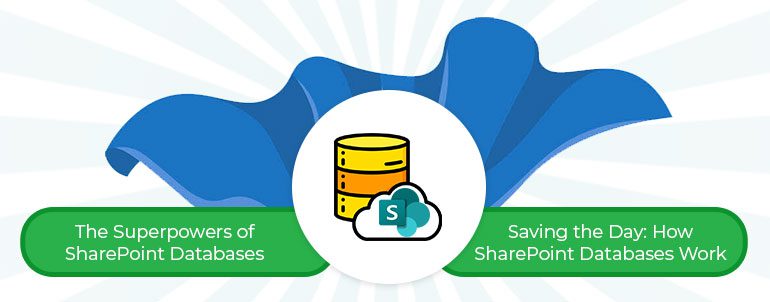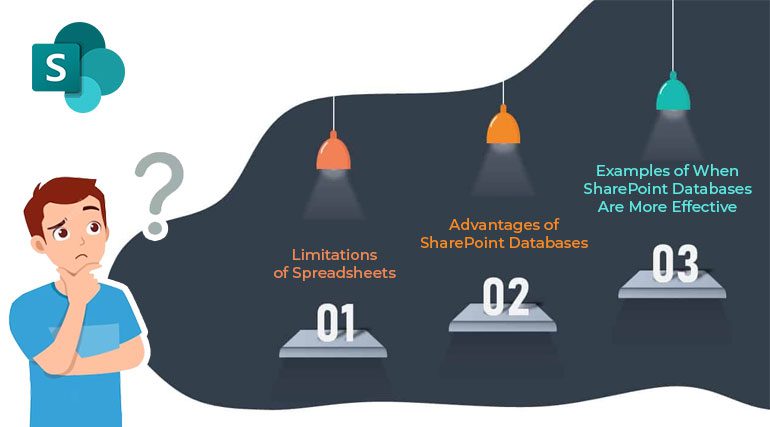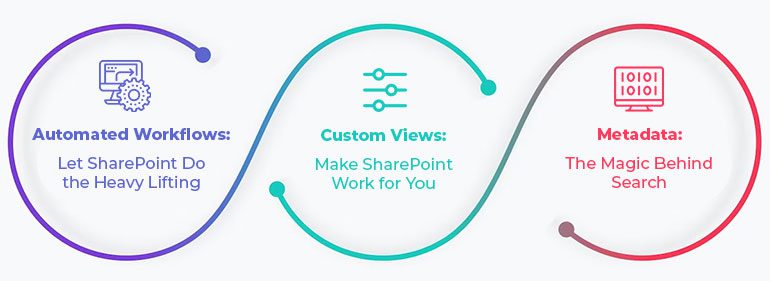Say Goodbye to Spreadsheet Chaos: How SharePoint Databases Can Help
Are you struggling to keep track of important data on multiple spreadsheets? Do you find yourself wasting time trying to reconcile conflicting information or manually updating figures? If you’re nodding your head in agreement, then it’s time to say goodbye to the chaos and hello to SharePoint databases.
SharePoint databases offer a simple yet powerful solution to manage your data effectively, providing a centralized location for all your important information. By using SharePoint databases, you can say goodbye to the confusion and frustration of managing multiple spreadsheets and hello to a streamlined and efficient data management system.
In this blog post, we’ll explore the benefits of SharePoint databases and how they can help you get organized, save time, and improve your productivity. We’ll also provide some tips for getting started with SharePoint databases and making the most of this powerful tool. So, if you’re ready to say goodbye to spreadsheet chaos, let’s dive in!
1. What Are SharePoint Databases? A Superhero for Data Management

So, you’re done managing your data on multiple spreadsheets? Welcome to the club! Let us introduce you to the superhero of data management – SharePoint databases!
SharePoint databases are like a centralized data fortress that can store all your information in one place. Plus, they’re not just for lone rangers – multiple users can access and edit the data, so you can work together as a team. It’s like having a personal assistant to help you manage your data!
- The Superpowers of SharePoint Databases
At their core, SharePoint databases are a superhero for data management. They allow you to store and organize large amounts of data in a single, secure location, making it easy to access and share with your team. The best part? SharePoint databases are customizable to meet your specific needs. Whether you’re a startup or an enterprise, you can tailor the database to fit your organization like a glove. And no, we’re not talking about Mickey Mouse glove. It’s more like a badass biker glove that gives you ultimate control over your data.
- Saving the Day: How SharePoint Databases Work
Now, let’s talk about the benefits. SharePoint databases are like the Swiss Army knife of data management. They can streamline your workflows and save you precious time. Plus, they’re super flexible – you can use them to manage anything from customer data to financial records. It’s like having a data butler that can do anything you ask it to do!
So, why settle for spreadsheets when you can have a data superhero? In the next section, we’ll show you why SharePoint databases are the way to go for data management.
2. Why Choose SharePoint Databases Over Spreadsheets?

Spreadsheets may have been a useful tool in the past, but they’re no match for the power and efficiency of SharePoint databases. Here are a few reasons why:
- Limitations of Spreadsheets
Spreadsheets can be difficult to maintain when multiple people are working on them. It’s easy to accidentally overwrite or delete important data, causing chaos and confusion. Plus, it can be time-consuming to update multiple spreadsheets with the same information, leading to errors and inaccuracies.
- Advantages of SharePoint Databases
SharePoint databases, on the other hand, provide a centralized location for all your data. This means you can access it quickly and easily, without having to sift through multiple spreadsheets. SharePoint databases also allow for real-time editing and collaboration, so everyone can stay on the same page.
- Examples of When SharePoint Databases Are More Effective
Let’s say you’re managing a project with multiple team members. With spreadsheets, it can be difficult to keep track of everyone’s progress and ensure that everyone is working on the same information. With SharePoint databases, you can create custom views to display only the information relevant to each team member, making it easier for everyone to stay on top of their tasks
Or maybe you’re managing customer data, and you need to quickly find specific information about a particular client. With spreadsheets, you’d have to search through multiple files to find what you’re looking for. With SharePoint databases, you can easily search and filter your data to find exactly what you need.
SharePoint databases are a superior solution for data management compared to spreadsheets. So, ditch those spreadsheets and upgrade to SharePoint databases for a more efficient and organized way of managing your data!
3. Getting Started with SharePoint Databases: Don’t Panic, It’s Easy!
Congratulations, you’ve decided to ditch those old spreadsheets and move into the 21st century with SharePoint databases! But where do you even begin? Don’t worry, setting up a SharePoint database is easier than you might think.
- From Zero to Hero: How to Input and Manage Data in SharePoint Databases
The first step is to create a new site in SharePoint. This will serve as the home base for your database. Think of it like building a virtual house – you need a strong foundation to support all your data.
Next, you’ll need to create your database. Think of this as building the rooms in your virtual house. You’ll want to create fields for all the different types of data you’ll be storing. For example, if you’re creating a customer database, you’ll want to create fields for name, address, phone number, etc.
Once you’ve created your database, it’s time to start inputting data. You can do this manually by filling out web forms or by uploading files directly. Think of it like moving all your old junk into your new virtual house. It might take some time to get everything set up, but once it’s done, you’ll wonder how you ever managed without it.
- Tips and Tricks for Optimizing Your SharePoint Database
To optimize your SharePoint database, you’ll want to make sure it’s tailored to your specific needs. This might mean creating custom views or workflows, or it might mean adding more fields to capture data that’s important to your organization. Think of it like decorating your virtual house – you want it to be functional and relaxing, but also reflect your personal style.
- Use folders to organize your data
- Create consistent naming conventions
- Use permissions to control who can access your data
- Regularly backup your SharePoint database (because accidents happen)
Getting started with SharePoint databases is a straightforward process that can save you time and headaches down the line. So why not take the dive and start building your virtual dream house today? (Just don’t forget to pay the virtual mortgage!)
4. Advanced Features and Tips

Ready to take your SharePoint game to the next level? Here are some advanced features and tips to help you become a true SharePoint master.
- Automated Workflows: Let SharePoint Do the Heavy Lifting
If you’re bored of spending countless hours on repetitive tasks, then you need to try automated workflows. SharePoint workflows can automate a variety of tasks, from sending emails to updating records, freeing up your time to focus on more crucial things like napping.
- Custom Views: Make SharePoint Work for You
Custom views are like personal assistants for your SharePoint database. With custom views, you can create different ways of viewing your data based on your needs. Want to see all the projects assigned to you? Create a custom view. Want to see all the projects with a high priority? Create a custom view. The possibilities are endless, just like your love for pizza.
- Metadata: The Magic Behind Search
Metadata is like the fairy dust that makes SharePoint search work like magic. By adding metadata to your documents, you make them easier to find when searching for specific information. Think of metadata like hashtags, but for SharePoint. And just like hashtags, the more metadata you add, the easier it is to find what you’re looking for.
With these advanced features and tips, you’ll be a SharePoint superstar in no time. Just remember to take breaks to rest your eyes and stretch your legs. And maybe have a slice of pizza or two.
5. Conclusion
Congratulations! You’re now a SharePoint database master, equipped with all the knowledge and skills you need to streamline your data management and boost your productivity. But wait, there’s more!
As with any software or tool, there are always ways to optimize and enhance your SharePoint databases. That’s where Beyond Intranet comes in. As a SharePoint consultant, we can help you take your databases to the next level and fully realize their potential.
Beyond Intranet has extensive experience working with SharePoint databases and can provide custom solutions tailored to your unique needs. Our team of experts will help you optimize your databases for maximum efficiency, implement advanced features such as automated workflows and custom views, and provide ongoing support to ensure your databases are always running smoothly.
So, what are you waiting for? Take your SharePoint databases to the next level with Beyond Intranet and experience the full range of benefits we have to offer. Contact us today to learn how we will assist you achieve your data management goals.
6. Additional Resources: Because Sharing is Caring!
If you’ve made it this far, congratulations! You’re now a SharePoint database expert (or at least close to it). But there’s always more to learn, and thankfully, there are multiple resources available to help you master the art of data management.
Here are some additional resources to check out:
- Beyond Intranet: If you need some extra help with your SharePoint database (or just want someone else to handle it for you), look no further than Beyond Intranet! Our team of SharePoint consultants can help you set up and customize your database to fit your organization’s specific needs. Plus, we’re pretty fun to work with (if we do say so ourselves).
- Microsoft Support: When in doubt, turn to the experts! Microsoft offers a range of support options for SharePoint, including forums, documentation, and personalized assistance. And if all else fails, you can always try turning your computer off and on again (just kidding…mostly).
- Online Courses: If you’re a visual learner or just prefer a more structured approach to learning, consider taking an online course in SharePoint. Sites like LinkedIn Learning, Udemy, and Pluralsight offer a variety of courses on SharePoint and data management.
- YouTube Tutorials: For the more adventurous learners out there, YouTube can be a great resource for learning about SharePoint databases. There are plenty of tutorials and walkthroughs available but be warned: some of them might be a little…quirky.
No matter what your preferred learning style is, there’s a resource out there for you. So go forth, share your knowledge, and help make the world a better (and more organized) place!






